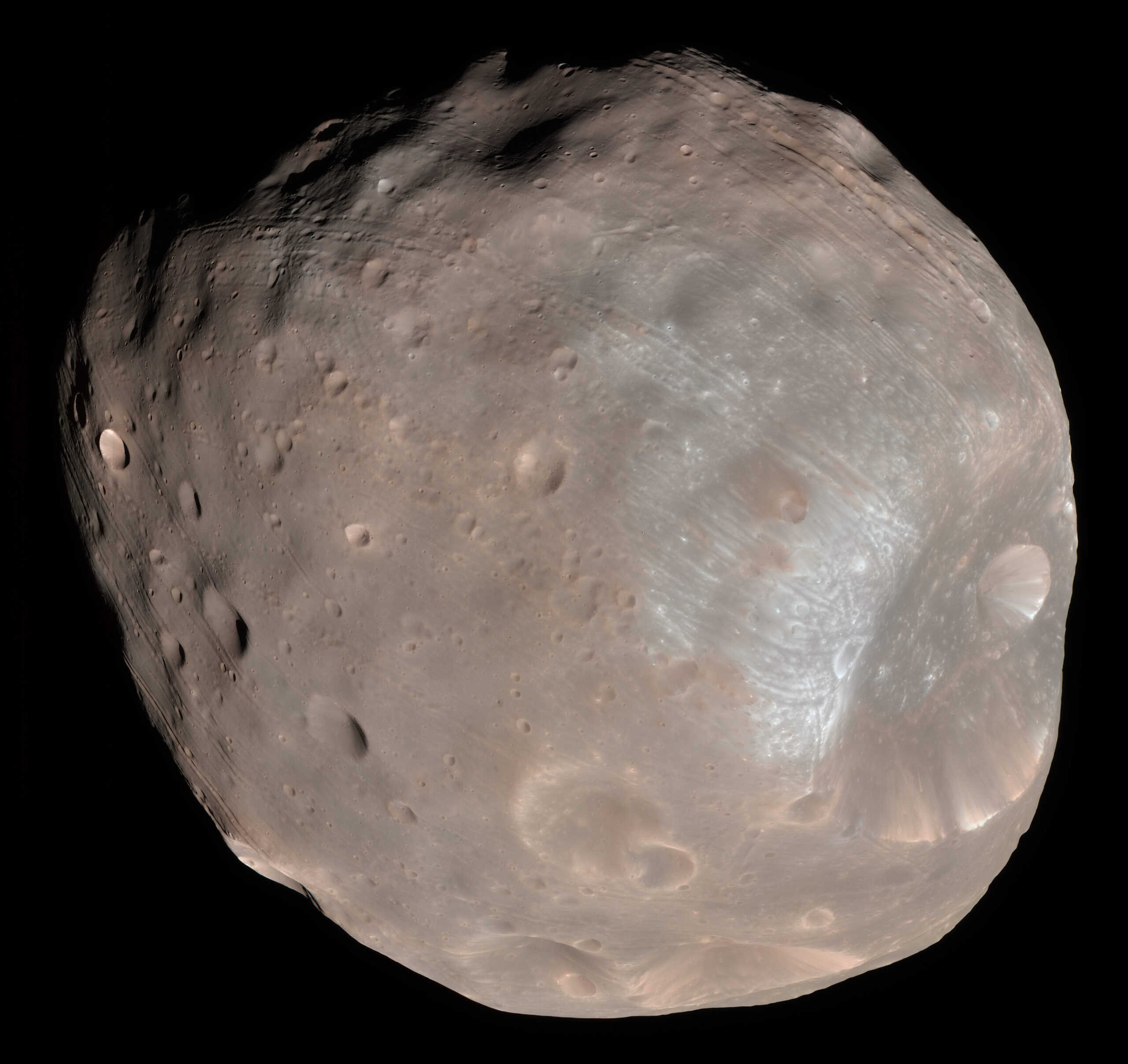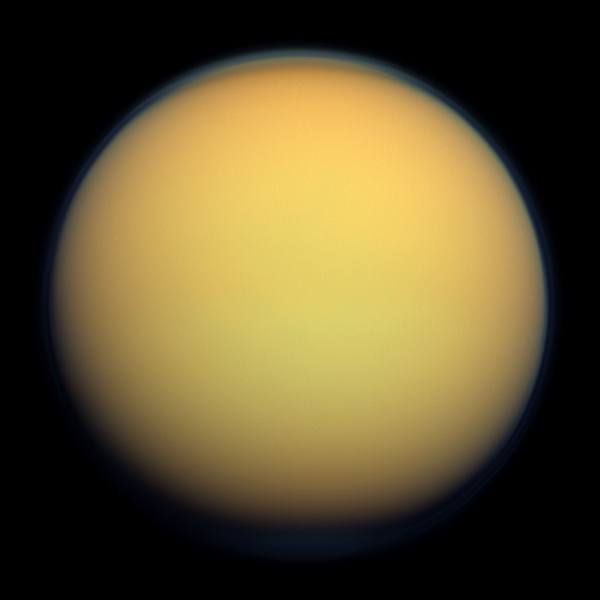*This post may contain affiliate links. This means we may make a commission if you purchase an item using one of our links*
Tha main differences between Phobos and Titan are that Titan is the bigger of the two with a diameter of 5,150km while Phobos’ diameter is 22.53km, Titan orbits Saturn while Phobos orbits Mars and Titan has an atmosphere 1.19 times thicker than Earth’s while Phobos has no atmosphere.
There are various other differences between the two so continue reading for a more detailed look at each body along with their similarities and differences below.
What Is The Moon Phobos?
Table of Contents

Phobos is the larger and innermost of the Martian moons, named after the Greek God of fear and panic. This rocky satellite measures approximately 27 x 22 x 18 kilometers and possesses an irregular shape.
Flying only 270 km above Mars’s surface, Phobos orbits the Martian surface so closely that it spins around the planet three times a day (each orbit takes 7 hours and 39 minutes). And this proximity means that the moon cannot always be seen from Mars’ surface (it all depends on where you’re standing).
In general, Phobos rises in the west, passes through the sky in around 4 hours, and sets in the east. And this process occurs twice during one Martian day.
Phobos travels 1.8 m closer to Mars every 100 years, which means this doomed moon will one day crash into its planet or break up into rings. Still, this won’t happen for another 50 million years or so.
The moon is covered in streak patterns from impact craters, the most significant of which is the crater Stickney, with a diameter of 9.7 km. Phobos has weathered thousands of meteorite impacts, one of which almost shattered it to pieces.
It was first discovered by the American astronomer Asaph Hall on 17th August 1877. But, it can be difficult for astronomers to see as it is one of the least reflective bodies in the solar system with an albedo of 0.071.
Despite its small stature, Phobos experiences wildly varying temperatures on its dark side compared to the light side. Measurements on the light side of the moon suggest that temperatures can rise to -4 degrees Celsius, a sort of brisk winter’s day that would be cold but tolerable.
In contrast, temperatures on the dark side can drop to -112 degrees Celsius, even though the two areas are just a few kilometers apart. The probable cause is fine surface dust that cannot retain heat, allowing temperatures to drop rapidly.
The low density of Phobos suggests its composition is similar to carbonaceous chondrite meteorites, which could mean that Phobos is a captured asteroid.
What Is The Moon Titan?

Titan is Saturn’s largest moon and the second biggest moon in the entire solar system, with a diameter of 5,150km. This would make it even larger than the planet Mercury which is only 4,879km, and significantly larger than Pluto also.
As a result, Titan’s gravitational strength stands at around 1.352 m/s²
It is the only natural satellite in our solar system that is composed similarly to Earth, where it has a thick atmosphere (1.19 times that of Earth) made primarily of nitrogen (95%) along with smaller amounts of methane (5%).
It has rivers and lakes on its surface along with a water cycle very similar to that of Earth, where essentially water evaporates and eventually lands on the satellites surface.
Therefore, much like Earth, Titan has a terrestrial based body but, there is a difference in their atmospheric pressure. The pressure on Titan’s surface is around 60% greater than that of Earth’s surface but, it isn’t nearly as dense.
Nevertheless, it is still far denser than most other bodies at 1.88 g/cm³. As a result, Titan’s mass is 1.345×10^23 kg.
In regards to its temperature, Titan is on the colder side where it averages around -179 degrees Celsius whilst its core’s temperature is actualluy very cold in comparison to other entities falling between 226 – 526 degrees Celsius.
As Saturn is the 6th farthest planet from the Sun, it will take Titan roughly the same amount of time to orbit the Sun, which would fall around 29.4 years.
It takes Titan 15 days and 22 hours to orbit Saturn. A day is 15 days and 22 hours also as it is tidally locked to the gas giant.
Similarities Between Phobos And Titan
As both are natural satellites, Titan and Phobos do share a few similarities, which includes the following:
- Both have a rocky, terrestrial surface.
- Neither have rings surrounding them.
- Both are tidally locked to their planet.
- Both orbit their planet in an elliptical pattern.
- Neither have a magnetic field.
- Neither have tectonic plates
Differences Between Phobos And Titan
As for the differences between the two, they include the below:
- Phobos orbits Mars whilst Titan orbits the Titan.
- Titan is a spherical shape while Phobos is not.
- Titan has a diameter of 5,150km whilst Phobos has a diameter of 22.53km.
- Phobos has no atmosphere whilst Titan’s atmosphere is 1.19 times as thick as Earth’s and is composed of nitrogen and smaller amounts of methane also.
- A day on Phobos takes 7 hours 39 minutes whilst a Titan day takes 15 days and 22 hours.
- It takes Phobos 7 hours 39 minutes to orbit Mars and around the Sun in 687 days whilst Titan orbits Saturn in 15 days and 22 hours and the Sun in 29.4 years.
- Titan has an axial tilt of 27 degrees whilst Phobos’ axial tilt is closer to 0.
- Phobos’ temperature ranges between -4 to -112 degrees Celsius whilst Titan’s average temperature is -179 degrees Celsius.
- Titan has a water cycle similar to that of Earth whilst Phobos does not have a water cycle.
- Titan orbits Saturn at an average distance of 1.2 million km whilst Phobos is 6,000km away from Mars.
- Titan’s density is 1.88 g/cm³ whilst Phobo’s density is 1.88 g/cm³.
- Titan’s mass is 1.345 × 10^23 kg whilst Phobos’ mass is 10.6 × 10^15 kg.
- Phobos’ gravitational strength is 0.0057 m/s² whilst Titan’s is 1.352 m/s².
- Phobos only orbits Mars 6,000km away and is getting closer to the planet by 1.8 meters every 100 years.
Summary
Titan and Phobos are both natural satellites that orbit their respective planets and are also tidally locked to their planets but, they differ in numerous ways too.
Whether it be in regards to mass, size, their water cycles, gravitational strength, how dense each body is and more. Therefore, despite the fact both are spherical and rock based celestial bodies, they have many distinct features that easily distinguish the two from one another.

